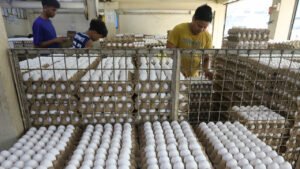[ad_1]

Reorganization of inflation A Moody’s Analytics economist said the biggest headache of the Philippines’s economic outlook this year could endanger the central bank’s relaxation cycle.
“The acceleration of inflation is the biggest risk to the Philippines economy, which comes from domestic and external factors,” said Sarah Dan of the Moody’s Analytics economist Sarah Dan Kathy talks with money Wednesday in a message.
“I think it is a risk of raising food inflation due to frequent weather disruption that can affect domestic distribution,” he said.
In January, inflation was 2.9%, although food inflation was alone from 3.5% to 4% in December.
Last year, many storms hit the country, resulting in billions of Besos worth agricultural damage.
“Externally, I think we are worried that the US imposed fees can cause global inflation due to disruption to the supply-chain networks,” Mrs. Dan said.
However, US President Donald J. He said the impact of Trump’s control business policies would be less on the Philippines.
“If we look back on a step back and see the trade relationship between the US and the US, it is clear that the trade deficit with the United States is very small, especially when you compare it to other economies, with the economies of the ASEAN (Southeast Asian Countries) economies.”
“The President of the President Trump means that the Philippines is not likely to be too much,” he added.
Since taking office in January, Mr. Trump has already slapped 10% fee on Chinese goods and all steel and aluminum imports in March.
On the other hand, Mr. Mr. Krishnan has to impose mutual fees in all countries that charge duties on US imports. Trump’s plan may have a very significant impact on the Philippines.
“If there is a global mutual fee that is imposed by the United States, it will affect the Philippines because the imports of the US are more than a different way to import the US.”
“If there is a fit of charges, it will make the Philippines more expensive and less competitive, which will eventually affect our Philippines manufacturers and exporters.”
The United States is generally the best place for the products made by the Philippines. By 2024, exports to the United States were estimated to be $ 12.12 billion or total exports of 16.6%.
“I believe the impact on the Philippines is small considering low trade expression with the United States. There are indirect channels of impact on the Philippines,” Mrs. Dan added.
Hazards to facilitate
Inflation pressures from these risks may be more aware of the Pango Central NG Pilipinas (BSP) to make it more ease of facilitating, Mrs. Dan said.
“If inflation is accelerated beyond the BSP’s goal, it may delay the time and quantity of a potential policy in the Philippines,” he said.
“If so, a combination of long -term increase in debt costs and inflation will be a recipe for further weakening in private consumption. This is not the best for the economy.
At the February 13 meeting, the BSP markets were unchanged by 5.75% and surprised the markets. This is after the Central Bank has reduced the rates at three -time meetings since its launching cycle in August.
Mrs. Dawn is the only economist Business World The opinion of 20 researchers who correctly predicted the grip.
“This is a balancing process. They must balance both inflation risks and the strength of Peso.”
“But we do not expect the suspension to be felt too long. In fact, the next rate cut may come in April, which will meet the Currency Board next time,” he added.
Despite the suspension, BSP Governor Eli M. Remolona said that the rate of reduction in the next rate of the Currency Board on April 3 is still on the schedule.
He said the Central Bank is still on the path to signal the possibility of cuttings worth 50 basic points (PBS) this year.
“Since inflation is now often withdrawn, the growth in GDP (GDP) is a little less than the government’s expectations,” Mrs. Dan added.
The GDP of the Philippines was slowly expanded by 5.2% expected in the fourth quarter. It brought about 5.6% of the full year 2024 growth, which is less than the government’s 6-6.5% target.
Meanwhile, Mrs. Dawn said the upcoming interim elections in May would be an encouragement to the costs.
“In general, elections, whether it is national or medieval, they need to give an incentive to the economy, especially through the Consumption Channel.”
“So we will see the costs of increasing campaign -related goods and services. But at the same time, you know that the increase in demand may also indicate the worst news of inflation,” he added. Louisa Maria Jasinda c. Jokeson
[ad_2]
Source link













